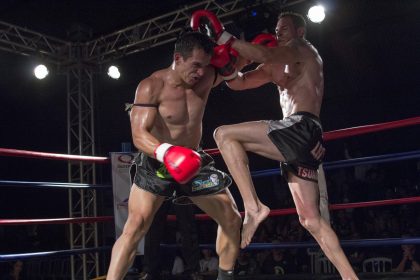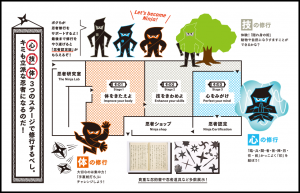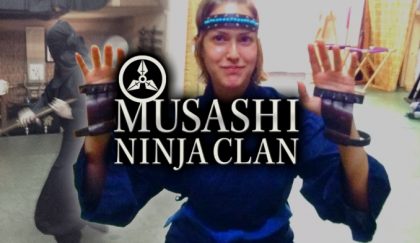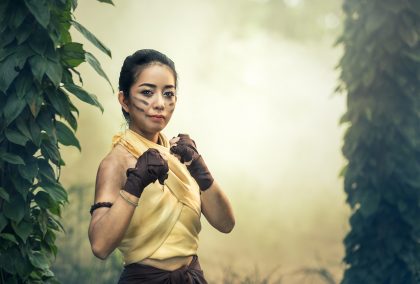Ninjas are beings shrouded by smoke and mirrors. Most people know the basics about these elusive warriors from Japan: that they did assassinations, worked with samurai, and threw shuriken.
Unfortunately, anime series like Naruto and the show Ninja Warrior haven’t done much to demystify what it means to train like a ninja would. That was when this fanatic stumbled upon the Hanayashiki Ninja Challenge in Asakusa, Tokyo, Japan and decided to investigate.
Asakusa is one of the few places in Japan where you can still see glimpses of the Edo period. Not only is the area famous for the Kaminarimon, also known as Thunder Gate, Nakamise Shopping Street, and the glorious Senso-ji Temple, Asakusa is also home to Japan’s oldest amusement park, Hanayashiki, which has been around since 1853. Though Hanayashiki is tiny in comparison to Fuji Q, for example, it has quite a few unique attractions. One of those is the “Ninja Taiken Dojo.”
History of Asakusa & the Ninja Taiken Dojo

Before I reserved my training session, I researched the history of Asakusa. During the Kamakura period (1185-1333), Shogun Yoritomo Minamoto dwelled in the area. Asakusa was mainly a bartering market until the 1600s, when a tea house was built and street performances were commonplace. Asakusa quickly became the epicentre of theatre in Edo-period Japan, but now only a few of those playhouses remain open for business.
One can only imagine how many samurai and ninja traversed the area throughout the years. But as for ninja operations in the area? There is not much.
In fact, one might be lead to think that the Hanayashiki Ninja Dojo has some back history. Sadly, that’s not the case. But I didn’t let that get in the way of an amazingly fun time.
Hanayashiki Ninja Taiken Dojo
The Ninja Taiken Dojo is located on the outside of the amusement park. Though there is a group entry point near the entrance to Hanayashiki, you are asked to report to the ninja store a little farther down the road. You can’t miss it. There are signs everywhere. Not very ninja-like, eh?
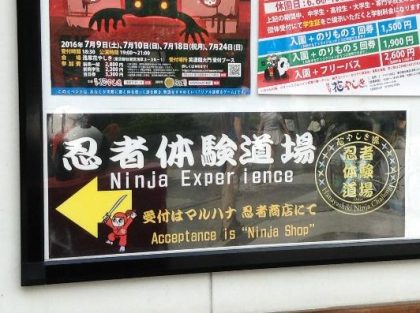
I had set my reservation for 1:00 PM and was certain it was going to be a one-on-one lesson, though up to 20 people can take the class together. Arriving slightly early, I was greeted by the cashier and a man clad in traditional ninja garb. I greeted them enthusiastically in Japanese and continued to say that I had made a reservation to take class. Though you can indeed take the Ninja Experience in English, when the ninja master realized I knew English, he was overjoyed. Apparently, the English version is rather rehearsed.
I was handed a nametag and a headband (hachimaki) to wear. The male ninja then told me that because I know Japanese, he was going to have the kunoichi sensei (female teacher) conduct my lesson. Then after a short wait, I was introduced the my teacher, who was dressed identically to the previous ninja. Both of them asked to be called Hanayashiki Ninzo-sensei, which is part of the roleplay as a ninja master.
You enter the “classroom” after a quick walk down a narrow hallway. Immediately I noticed the targets for shuriken-throwing practice, a row of seats, and a stage. There was also a huge mirrored wall. Before starting the actual presentation, my teacher asked what I knew about ninja. I reported that I know quite a bit of ninja history from studying the Sengoku and Edo periods then offered up the name “Mochizuki Chiyome.”
“Mochizuki? I’m not sure I ever heard of Mochizuki ninja,” confessed Sensei.
I told her the details about Mochizuki Chiyome, who supposedly created an all-female spy unit during the 16th century under the guidance of the Takeda clan. Impressed, my teacher said that most people who come to the attraction usually only know ninja from two sources: anime and movies. And so it became evident that the Hanayashiki Ninja Experience does not aim to exactly dissolve the myths surrounding ninja.
Techniques taught at Hanayashiki Ninja Taiken Dojo


The contents of the presentation included an introduction to calming the mind, swordplay, concealment techniques and shuriken-throwing.
Mind technique
We started the lesson by calming our minds. Sensei gave a detailed explanation about the hand gestures and words used in the mantra for relaxation.
First, either standing or kneeling, you imagine your less dominant hand as the sheath of your “heart-blade,” or your writing hand (pointer and middle finger extended like a sword). You draw your sword and hold it front of you. Then, drawing the kanji for 10 (十), you strongly saying, “Rin, pyou, tou, sha, kai, jin, retsu, zai, zen!” With a deep inhale and exhale, you take a moment to focus on your center. From there, you’re ready for whatever task your warlord has asked you to accomplish.
Swordplay
Next, Sensei introduced me to swordplay. Using wooden swords, we took to the stage and faced the mirror. We practiced holding the wakizashi (short sword), drawing the blade, taking a すり足 (suriashi) or slide-step, then sheathing the blade. Though I exceled at the draw and step, not looking at the blade while stowing it was more difficult than expected. Sensei even laughed and said, “If you did that during battle, you’d die, you know.”
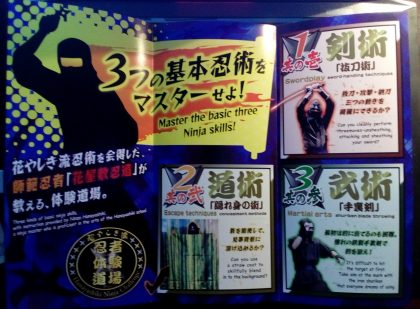
Illusion Techniques – Bamboo-printed Curtain
From there, I was shown the illusionary techniques of the ninja. We turned to a bamboo-printed curtain that connected to a wall painted to mimic a castle partition. I was handed a reversible fabric identical to, you guessed it, the bamboo and castle images. Because Sensei wanted to challenge me, she handed me a cloth much shorter than my actual height and said, “I don’t want to see your feet or your head.” Easier said than done! Switching from the bamboo side to the castle side required a simultaneously movement of swivelling your hands and back swiftly, without revealing yourself. Somehow I managed to do this all in a crouch and arrived at the “escape door,” where I had to drop the curtain and strike a ninja pose.
Shuriken-throwing
Last was shuriken throwing. There was a short introduction to different shuriken shapes and throwing techniques. The coordination of a step and flick of the wrist took a little practice, but we gradually increased the distance to 600 meters. We “duelled” one another to see who could hit the target more. Somehow, I won. Sensei told me that she’s not especially skilled with shuriken-throwing and recommended the Iga Ninja School in Mie, where you can use several types of shuriken and go beyond 600 meters.
Thoughts about Hanayashiki
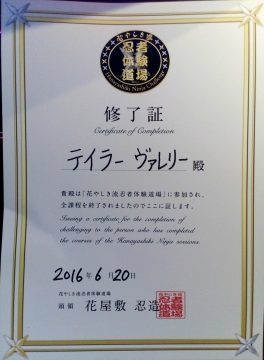
At the end of the training, you are presented with a certificate. You are also granted a 10% discount on merchandise at the ninja shop. Because we had some time before the end of the class time, I was allowed to play with an unsharpened katana. My inner geek was super giddy.
Overall, are you going to walk away feeling like a super ninja warrior? No. The Hanayashiki Ninja Challenge is more for the entertainment value rather than a rigorous physically and mentally experience.
I totally recommend it, especially for children. For the price of the attraction, it is definitely worth a go.
On the other hand, if you are seeking a true challenge, you might feel slightly disappointed. If you want a look into the secrets of ninjutsu, you won’t find them here. The Hanayashiki Ninja Dojo is an amusement park creation, after all.

